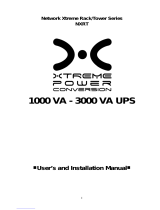
2
All battery installation and maintenance operations entail gaining
access to the inside of the UPS and require the use of tools: these
operations are to be performed exclusively by qualified staff.
The batteries replaced are to be considered as toxic waste and treated
accordingly. Dispose of used batteries according to the instructions.
Do not throw the batteries into fire: they could explode. Do not attempt
to open the battery casing: no maintenance work can be done on
them. In addition, the electrolyte is hazardous for the skin and eyes
and may be toxic.
Risk of explosion if battery is replaced by an incorrect type.
Do not turn on the UPS if you see any leaks of liquid or a white
powder residue.
Make sure that no water, liquid in general and/or other foreign matter
gets inside the UPS.
Under hazardous conditions, turn off the UPS at the “1/0” main power
switch and open all the isolators present (see the user manual to
locate the “1/0” main power switch and the isolators).
Do not open the battery fuse holders while the UPS is powering the
load from the batteries. An interruption of the battery DC voltage may
cause an electric arc and result in breakage of the equipment and/or
fire.
The energy required to power the load is provided by the batteries in
the event of a power failure. if the battery protection were open, the
load would be powered off.
Fuses have to be replaced with the same type if necessary.
To connect external battery cabinets, use the expansion cable
suggested by the manufacturer in this manual.






















